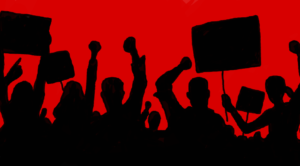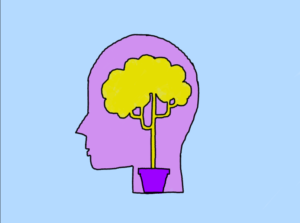Mindsets and Movements: Trauma Dumping
Social media opens the door to increased connection, especially among teenagers, but that openness could exacerbate mental health issues
May 19, 2022
Netflix’s controversial “13 Reasons Why” sparked what felt like the largest, most complex discussion about mental health in my memory. The show, based on a novel of the same name, followed Clay Jensen’s discovery of 13 cassette tapes that high schooler Hannah Baker recorded to explain why she killed herself.
The show sparked national discussion about mental health and teen suicude, for better or worse. And this is in large part due to how shocking and raw the content was, namely the graphic depiction of Baker’s suicide in the season one finale. Experts worried that the explicit content would trigger “imitative behavior” in students.
This fear manifested in real life, as a study from the National Institutes of Health confirmed. The first season’s release was correlated with a 28.9% increase in the youth suicide rate. Though the NIH admitted they could not find a definitive causal relationship, they did urge media producers to take care in how they present suicide, making sure to not show the methods used in graphic detail and clearly demonstrate that there are resources available to get help.
Before the third season of the show, Netflix announced that they edited out the graphic parts of the season one finale to address these concerns. In show creator Brian Yorkey’s statement, he explained “It was our hope, in making ‘13 Reasons Why’ into a television show, to tell a story that would help young viewers feel seen and heard, and encourage empathy in all who viewed it”.
Many who defended the show used similar language, arguing that the show started conversations and brought light to conversations about mental health that are vital for societal progress.
What I learned from the “13 Reasons Why” controversy is that talking about mental health is important, but talking about mental health is triggering. Both of these things are true, and as these conversations develop, it is absolutely critical that we allow discussion of mental health disorders to be frank without letting them be casual.
A report from the National Academies of Sciences, Engineering and Medicine recommended that the US government take steps to systemically destigmatize mental health problems. They argued that current negative preconceptions about mental health dissuade people from getting professional help, and are therefore detrimental to public health. It is often with this framework that influencers are encouraged to be open about their own struggles. By demonstrating what they’ve been through or are going through, influencers can model responsible behavior and prove that there are ways to get out of a dark place.
DVHS Counselor Ms. Carrie Fox agreed with these ideals, explaining that normalizing mental health means “normalizing the idea that it’s that mental health is regular health and being able to ask for help in that way is something that you shouldn’t be stigmatized for.”
But there is a fine line between normalization and glamorization. A study published in the Journal of Teaching and Education argued that in many ways, social media has crossed that line. Rola Jadayel, Karim Medlej and Jinan Jennifer Jadayel explained that normalizing mental health issues has a clear consequence: making severe problems feel normal. One focus group participant of that study explained, “Social media is romanticizing depression; you stop seeing it as a mental illness but a way of life.”
The complex relationship between oversharing and vulnerability also comes into play in real life, and the DVHS GSA is a real life example. The club often acts as a support group, letting people share what they’re dealing with. But President Alex Reyes explained the club is careful to state boundaries, “When we open the floor for people to speak, [officers] say ‘please be mindful, please don’t trauma dump or say anything super triggering.’”
In classroom settings, where upsetting content can be key to education, teachers may offer trigger warnings. The New Yorker’s Jeannie Suk Gersen explored the controversy surrounding trigger warnings in an academic setting. Gersen explained that conventional wisdom posits that if content has the potential to trigger students with PTSD, then students should be given advance notice to prepare themselves.
Reyes agreed with the logic, explaining that “the line between ranting to someone and trauma dumping is consent.”
Gersen cited many recent studies which found that trigger warnings are best ineffective, and at worse actually exaggerate the negative impact of triggering content. Psychologists have proposed a few reasons for this trend. The “clinical consensus” is that avoiding triggers worsen PTSD, so if students opt out of upsetting content it may harm them in the long run. However, most students “forge ahead” with the reading when given warnings, but are now aware of how it may impact them. Gersen suggests that this plays a role in making triggers seem more central to the student’s identity, rather than peripheral. This is also a factor that can worsen symptoms of PTSD.
However, the studies aren’t consistent as a report in the Journal of Experimental Social Psychology found that trigger warnings increase anticipated negative effect and decrease experienced negative effect for essays and videos.
Trigger warnings are a relatively recent concept, and we are far from an academic consensus. However, if they really are ineffective, that implies that the problem is not just in how people flag upsetting content, but the content itself.
This isn’t to say that we shouldn’t discuss difficult topics. Rather, social media forces us to examine our social script when we spread awareness about difficult issues.
In activist spaces, this complicated dynamic is most often discussed in the context of police brutality. Dr. Alifee Breland-Noble, founder of the Aakoma Project, said that videos of Black people being shot or killed by the police should not be so casually circulated around news stations or social media, as these videos can incite “secondary and vicarious trauma”.
Breland-Noble is steadfast in her belief that these videos aren’t necessary to spread awareness of the larger injustices at play. She argued that the explosive response to George Floyd’s murder, for example, was a result of the country already being ready for change, not because of the graphic video of his death.
However, the videographer’s Pulitzer disagrees, saying that the video sparked the protest and is “highlighting the crucial role of citizens in journalists’ quest for truth and justice”.
This perspective agrees with those who drew parallels between George Floyd and Emmett Till, whose death kickstarted the Civil Rights Movement of the 1960’s. 2020’s America and 1955’s America were both at a breaking point, the brink of intense revolution. But these tragedies defined so much of that revolution, and it’s hard to see the progress and the catalyst as completely separate.
This dynamic makes me recall my first installment of this column, about rioting. Similar to violence itself, violent imagery is a tool available to activists. It might be the only way to truly capture the gravity of a situation and force awareness, but in doing so, it causes destruction that cannot be ignored. Secondary trauma and normalization of violence against people of color isn’t as blatant as looting and burning, but it is damage all the same.
And just like in that first column, I struggle to find a good call to action. We need to discuss difficult issues, both personal and systemic. In doing so, people are hurt. In a world full of triggering issues, it’s impossible to get rid of that impact. To an extent, that hurt is what drives social movements and creates change. But we can’t expect people to sacrifice their mental health for the sake of activism. To grapple with this complexity, we have to be thoughtful in how we share and how much, and we must allow flexibility in how people consume that content





